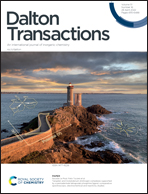Metal–metal communication between 1,1′-bis(diphenylphosphino)cobaltocenium and an organonickel moiety†
Abstract
1,1′-Bis(diphenylphosphino)cobaltocenium (dppc)+, similar to 1,1′-bis(diphenylphosphino)ferrocene, can be coordinated by dicarbonylnickel(0) or cyclopentadienylnickel(II), respectively. The cyclic voltammogram of [Ni(CO)2(dppc)]+ ([1]+) showed two reversible reductions, at potentails nearly identical to (dppc)+. The ligand-based reductions were confirmed by IR spectroelectrochemistry (SEC), although the ΔνCO was larger than might be expected if the ligand was electronically decoupled to the Ni(CO)2 moiety. The larger ΔνCO was attibuted to changes in the donor/accpetor properties of the –PPh2 moeities based on the occupation of the Co–Cp anti-bonding orbital, where the Cp ligand adopts an ylide-like structure. A similar analysis was performed on [CpNi(dppc)]2+ ([2]2+), where the two reductions were anodically shifted by ΔE = 292 and 520 mV from (dppc)+, indicating an increase in the M–M communication. The EPR SEC spectrum for [2]+ showed that the cobalt was reduced, while the UV-Vis-NIR SEC spectrum for [2]+ showed a NIR absportion at 1200 nm assinged as a MMCT CoII → NiII band. The second reduction formed [2]0 which was EPR silent but the UV-Vis-NIR SEC spectrum showed an increase in the intensity of the MMCT CoI → NiII.



 Please wait while we load your content...
Please wait while we load your content...